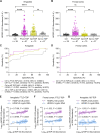HDGFL2 cryptic proteins report presence of TDP-43 pathology in neurodegenerative diseases
- PMID: 38539264
- PMCID: PMC10967196
- DOI: 10.1186/s13024-024-00718-8
HDGFL2 cryptic proteins report presence of TDP-43 pathology in neurodegenerative diseases
Erratum in
-
Correction: HDGFL2 cryptic proteins report presence of TDP-43 pathology in neurodegenerative diseases.Mol Neurodegener. 2024 Jul 27;19(1):56. doi: 10.1186/s13024-024-00744-6. Mol Neurodegener. 2024. PMID: 39068448 Free PMC article. No abstract available.
Abstract
This letter demonstrates the potential of novel cryptic proteins resulting from TAR DNA-binding protein 43 (TDP-43) dysfunction as markers of TDP-43 pathology in neurodegenerative diseases.
© 2024. The Author(s).
Conflict of interest statement
B.F.B. receives institutional research grant support from Alector, Biogen, Transposon, Cognition Therapeutics, and GE Healthcare. B.F.B. receives an honorarium for SAB activities for the Tau Consortium. L.P. is a consultant for Expansion Therapeutics. D.S.K. serves on a Data Safety Monitoring Board for the Dominantly Inherited Alzheimer Network Treatment Unit study. D.S.K. served on a Data Safety monitoring Board for a tau therapeutic for Biogen (until 2021) but received no personal compensation. D.S.K. is an investigator in clinical trials sponsored by Biogen, Lilly Pharmaceuticals, and the University of Southern California. D.S.K. has served as a consultant for Roche, Samus Therapeutics, Magellan Health, Biovie and Alzeca Biosciences but receives no personal compensation. D.S.K. attended an Eisai advisory board meeting for lecanemab. A.D.G. is a scientific founder of Maze Therapeutics.
Figures

References
-
- Melamed Z, Lopez-Erauskin J, Baughn MW, Zhang O, Drenner K, Sun Y, Freyermuth F, McMahon MA, Beccari MS, Artates JW, et al. Premature polyadenylation-mediated loss of stathmin-2 is a hallmark of TDP-43-dependent neurodegeneration. Nat Neurosci. 2019;22:180–90. 10.1038/s41593-018-0293-z - DOI - PMC - PubMed
-
- Klim JR, Williams LA, Limone F, Guerra San Juan I, Davis-Dusenbery BN, Mordes DA, Burberry A, Steinbaugh MJ, Gamage KK, Kirchner R, et al. ALS-implicated protein TDP-43 sustains levels of STMN2, a mediator of motor neuron growth and repair. Nat Neurosci. 2019;22:167–79. 10.1038/s41593-018-0300-4 - DOI - PMC - PubMed
Publication types
MeSH terms
Substances
Grants and funding
- R35NS097273 (17,24)/NS/NINDS NIH HHS/United States
- U54NS123743/NS/NINDS NIH HHS/United States
- 5P30AG0062677/AG/NIA NIH HHS/United States
- R21 NS127331/NS/NINDS NIH HHS/United States
- P01 NS084974/NS/NINDS NIH HHS/United States
- R01 AG037491/AG/NIA NIH HHS/United States
- R01NS117461/NS/NINDS NIH HHS/United States
- RF1 NS120992/NS/NINDS NIH HHS/United States
- RF1NS120992/NS/NINDS NIH HHS/United States
- R35 NS097273/NS/NINDS NIH HHS/United States
- P01NS084974/NS/NINDS NIH HHS/United States
- R01 NS120992/NS/NINDS NIH HHS/United States
- U19AG063911/AG/NIA NIH HHS/United States
- R21NS127331/NS/NINDS NIH HHS/United States
- R35NS097263(10,10)/NS/NINDS NIH HHS/United States
- R01 NS117461/NS/NINDS NIH HHS/United States
- R35 NS097263/NS/NINDS NIH HHS/United States
- R01AG37491/AG/NIA NIH HHS/United States
LinkOut - more resources
Full Text Sources
Medical

